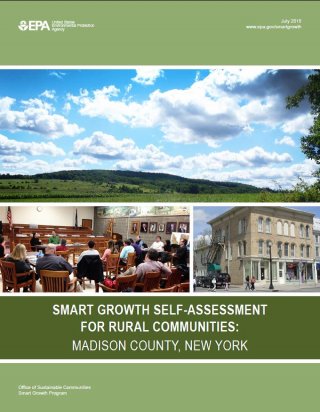Smart Growth Self-Assessment for Rural Communities: Madison County
The Smart Growth Self-Assessment for Rural Communities: Madison County, NY (pdf) is intended to help local governments evaluate how well their policies and regulations support the type of development they want and identify strategies for improvement. It focuses on issues that are unique to rural areas while acknowledging that rural communities are diverse.
While this tool was designed in collaboration with Madison County in 2015, any rural community can use the self-assessment. It focuses on issues that are unique to rural areas while acknowledging that rural communities are diverse.
On this page:
On other pages:
- Find more resources on smart growth in small towns and rural communities.
Structure of the Self-Assessment

The smart growth self-assessment tool for rural communities is divided into sections based on "goal areas." These goal areas include:
- Revitalize village and town centers.
- Strengthen the local economy.
- Engage and connect community members.
- Improve health and promote active living.
- Protect natural habitats and ecosystems.
- Support productive agriculture for a variety of markets.
- Meet housing needs for different ages and incomes.
- Preserve historic and cultural resources.
- Provide transportation choices.
- Invest in efficient public infrastructure systems and operations.
- Use energy efficiently and provide renewable energy.
Each section includes a series of questions about the community's policies, codes, and strategies that might help the community achieve its long-term objectives.
Following the questions are strategies, grouped according to whether they apply to larger towns or more rural areas, which support the overall goal. The tool also helps users prioritize strategies to pursue.
In addition to the self-assessment tool, this report includes a case study of smart growth planning in Dryden, New York. Dryden, a town of 15,000 residents, used various smart growth approaches to increase housing choices and address the loss of agricultural land. Dryden illustrates several strategies like those explored in the self-assessment tool that can help rural local governments achieve a wide range of community goals.
Finally, the tool includes links to case studies, sample code language, and other resources.
Creation of the Tool
In 2012, Madison County asked EPA's Smart Growth Implementation Assistance Program for help developing a smart growth self-assessment tool for rural communities. The county was facing many of the same challenges as other rural communities around the country: development encroaching on working farmlands and scenic areas, an aging population with increasing health problems, and slow or no population growth.
In addition, the county's local governments had widely varying levels of staff and technical capacity to improve policy coordination. About half of Madison County's municipalities didn't have comprehensive plans, and many lacked a zoning ordinance or planning board.
EPA tested the tool in three rural communities in Madison County— the small city of Oneida, the town of Brookfield, and the village of Chittenango.
